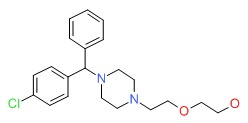NCBI Bookshelf. A service of the National Library of Medicine, National Institutes of Health.
LiverTox: Clinical and Research Information on Drug-Induced Liver Injury [Internet]. Bethesda (MD): National Institute of Diabetes and Digestive and Kidney Diseases; 2012-.

LiverTox: Clinical and Research Information on Drug-Induced Liver Injury [Internet].
Show detailsOVERVIEW
Introduction
Hydroxyzine is a first generation antihistamine that is used largely for symptoms of itching, nausea, anxiety and tension. Hydroxyzine has not been linked to instances of clinically apparent acute liver injury.
Background
Hydroxyzine (hye drox' i zeen) is a first generation antihistamine that is used mostly to treat itching and nausea. Because of its sedating effects, hydroxyzine is also used for anxiety, tension and as a mild sleeping aid. Hydroxyzine belongs to the piperazine class of antihistamines (with cyclizine and meclizine) which are more commonly used for itching, nausea and anxiety than for their effects on symptoms of allergic rhinitis or coryza. Hydroxyzine was approved for use in the United States in 1957 and continues to be widely used. It is available as tablets or capsules of 10, 25, 50 and 100 mg in multiple generic forms and under the trade names Atarax and Vistaril. Hydroxyzine is also available as an oral suspension or syrup and as a liquid for injection. Most formulations are available without prescription. The recommended adult oral dose ranges from 25 to 100 mg three to four times daily. Doses used for itching are generally lower than those for anxiety and tension. Common side effects include sedation, impairment of motor function, confusion, dizziness, blurred vision, dry mouth and throat, palpitations, tachycardia, abdominal distress, constipation and headache. Antihistamines can worsen urinary retention and glaucoma.
Hepatotoxicity
Despite widespread use, hydroxyzine has not been linked to liver test abnormalities or to clinically apparent liver injury. Indeed, hydroxyzine is commonly used for the pruritus associated with liver disease. The reason for its safety may relate to low daily dose and limited duration of use.
Likelihood score: E (unlikely to be a cause of clinically apparent liver injury).
References on the safety and potential hepatotoxicity of antihistamines are given together after the Overview section on Antihistamines.
Drug Class: Antihistamines
PRODUCT INFORMATION
REPRESENTATIVE TRADE NAMES
Hydroxyzine – Generic, Atarax®, Vistaril®
DRUG CLASS
Antihistamines
Product labeling at DailyMed, National Library of Medicine, NIH
CHEMICAL FORMULA AND STRUCTURE
| DRUG | CAS REGISTRY NUMBER | MOLECULAR FORMULA | STRUCTURE |
|---|---|---|---|
| Hydroxyzine | 68-88-2 | C21-H27-Cl-N2-O2 |
 |
- Hydroxyzine for lowering patient's anxiety during prehospital morphine analgesia: A prospective randomized double blind study.[Am J Emerg Med. 2021]Hydroxyzine for lowering patient's anxiety during prehospital morphine analgesia: A prospective randomized double blind study.Houze-Cerfon CH, Balen F, Houze-Cerfon V, Motuel J, Battefort F, Bounes V. Am J Emerg Med. 2021 Dec; 50:753-757. Epub 2021 Oct 1.
- Night-time sedating H1 -antihistamine increases daytime somnolence but not treatment efficacy in chronic spontaneous urticaria: a randomized controlled trial.[Br J Dermatol. 2014]Night-time sedating H1 -antihistamine increases daytime somnolence but not treatment efficacy in chronic spontaneous urticaria: a randomized controlled trial.Staevska M, Gugutkova M, Lazarova C, Kralimarkova T, Dimitrov V, Zuberbier T, Church MK, Popov TA. Br J Dermatol. 2014 Jul; 171(1):148-54. Epub 2014 May 26.
- Hydroxyzine Use in Preschool Children and Its Effect on Neurodevelopment: A Population-Based Longitudinal Study.[Front Psychiatry. 2021]Hydroxyzine Use in Preschool Children and Its Effect on Neurodevelopment: A Population-Based Longitudinal Study.Gober HJ, Li KH, Yan K, Bailey AJ, Carleton BC. Front Psychiatry. 2021; 12:721875. Epub 2022 Jan 28.
- Review Physicochemical, pharmacological and pharmacokinetic properties of the zwitterionic antihistamines cetirizine and levocetirizine.[Curr Med Chem. 2008]Review Physicochemical, pharmacological and pharmacokinetic properties of the zwitterionic antihistamines cetirizine and levocetirizine.Chen C. Curr Med Chem. 2008; 15(21):2173-91.
- Review Dimenhydrinate.[LiverTox: Clinical and Researc...]Review Dimenhydrinate.. LiverTox: Clinical and Research Information on Drug-Induced Liver Injury. 2012
- Hydroxyzine - LiverToxHydroxyzine - LiverTox
Your browsing activity is empty.
Activity recording is turned off.
See more...